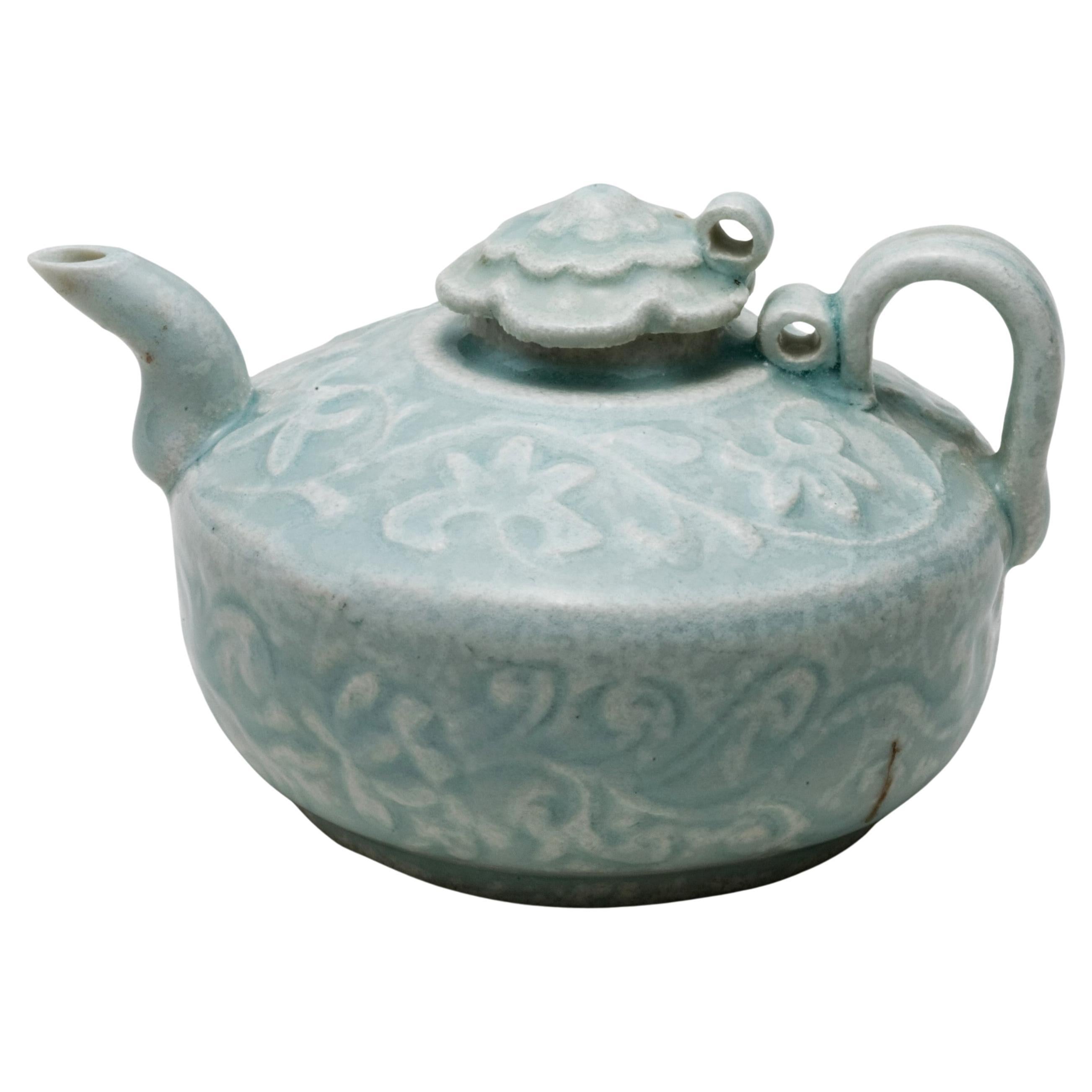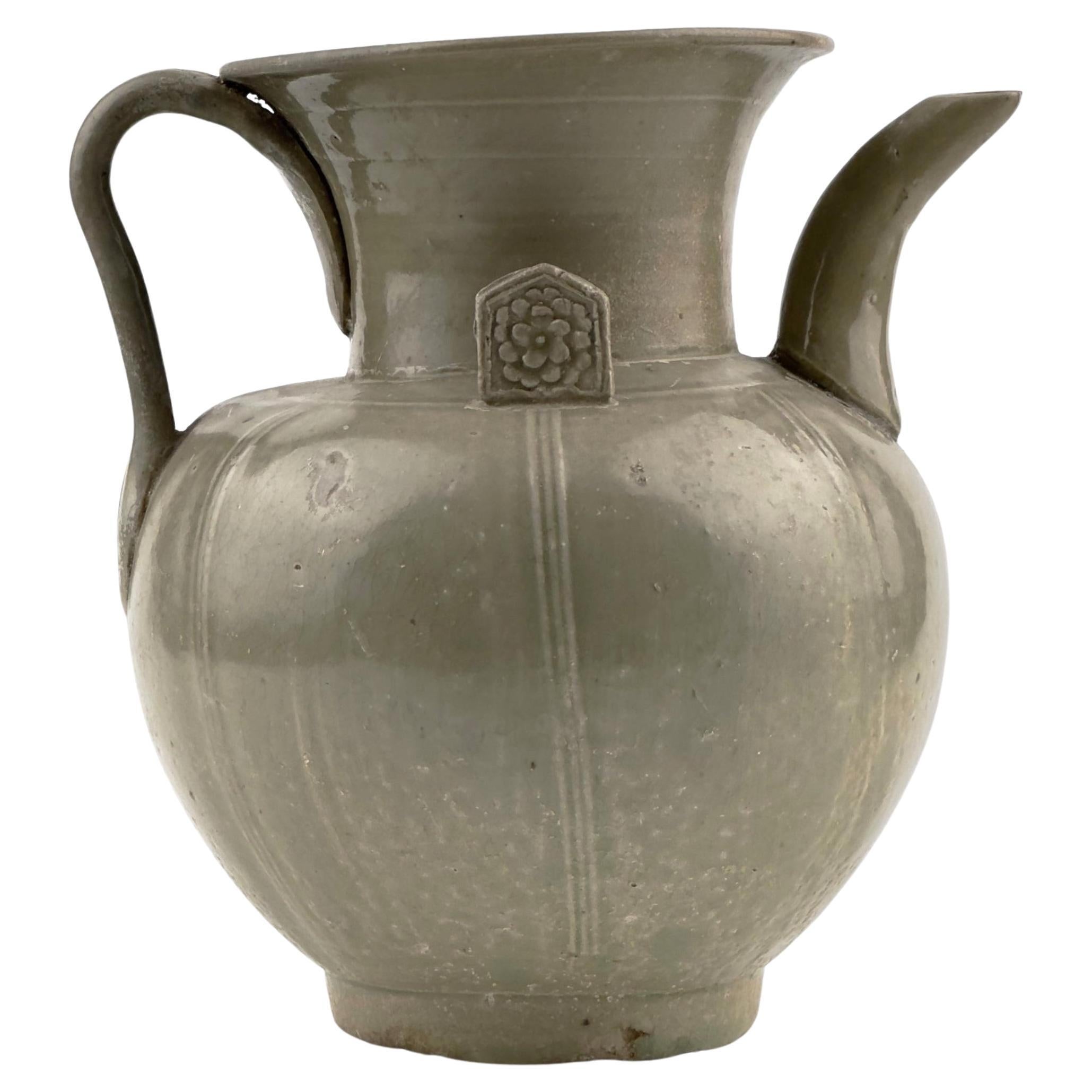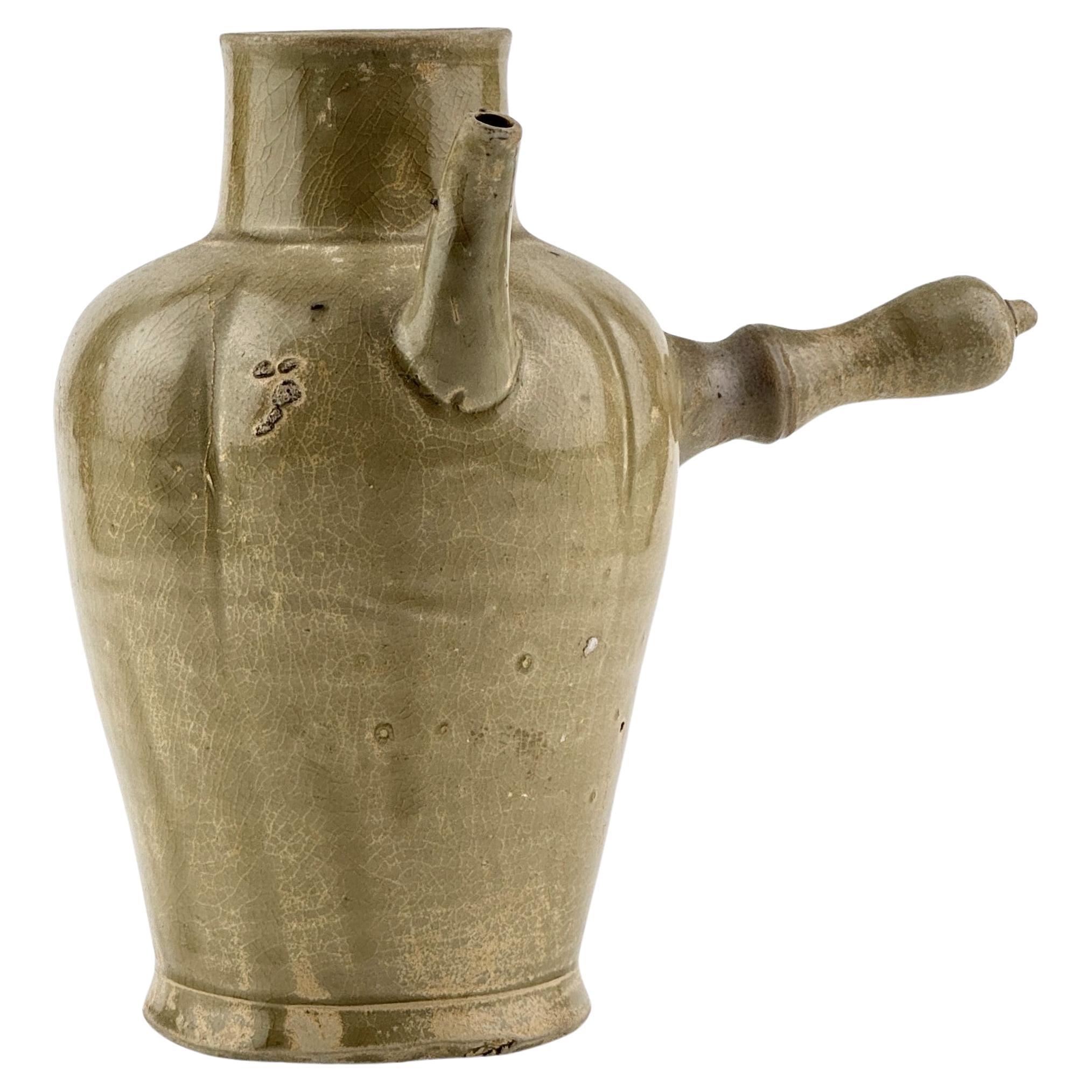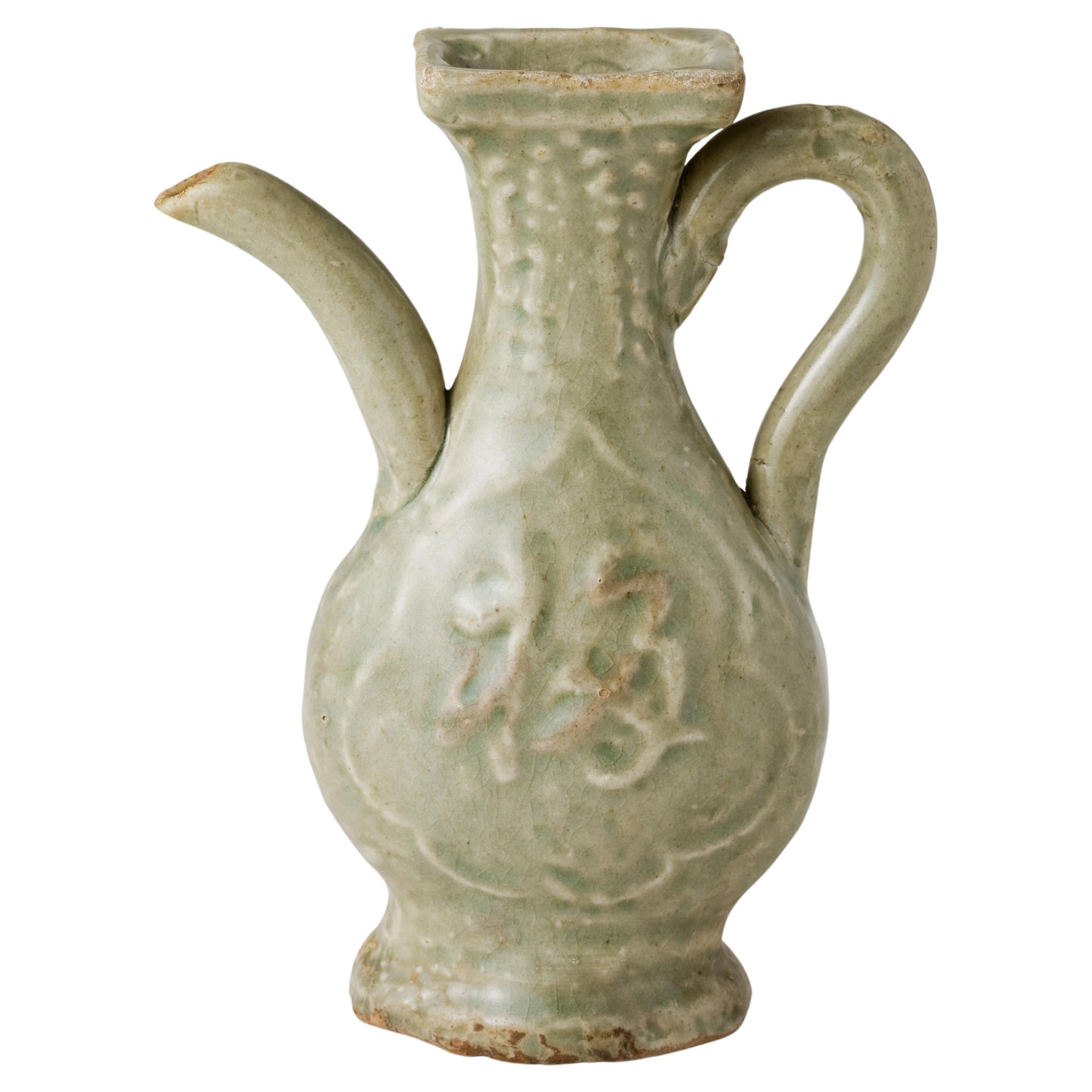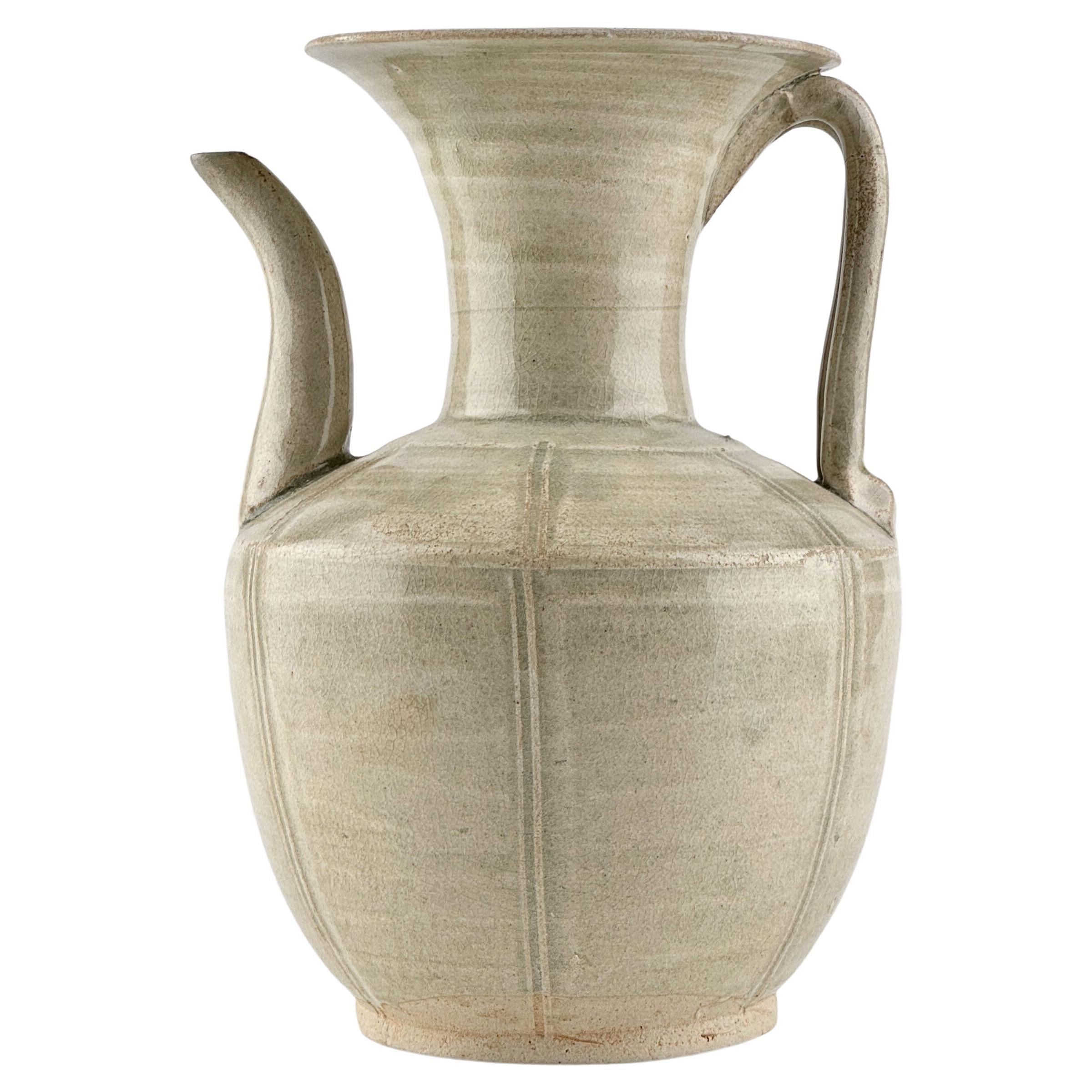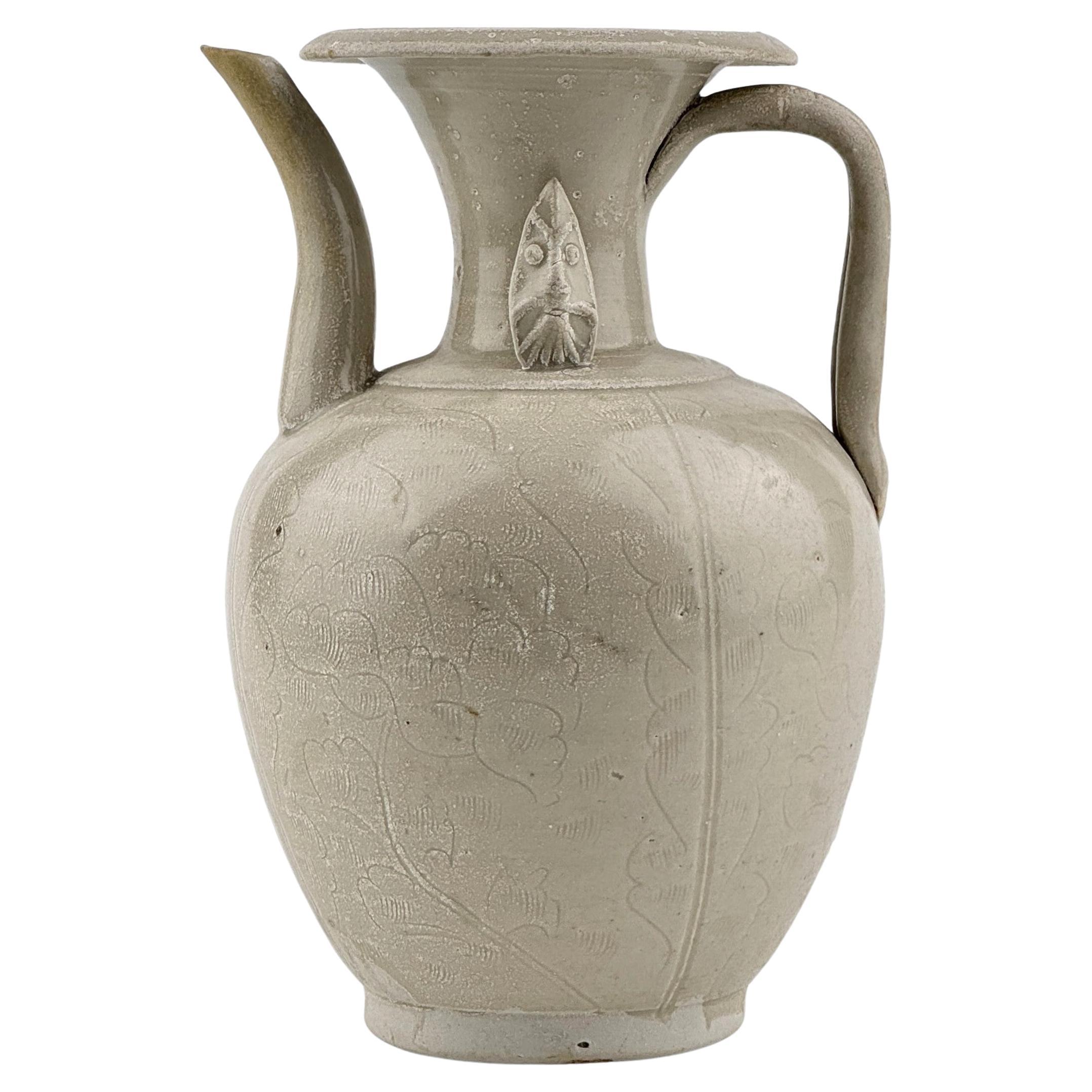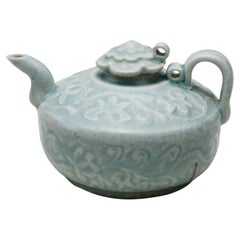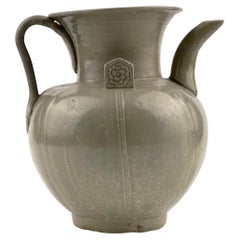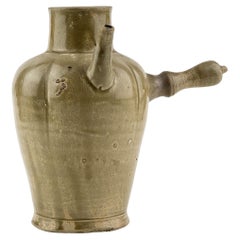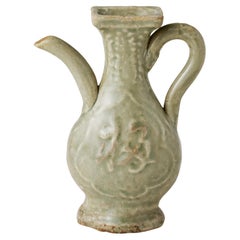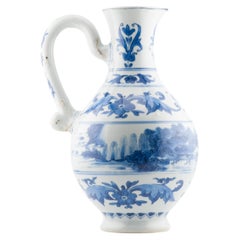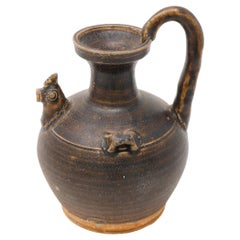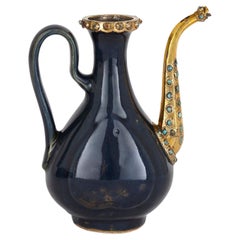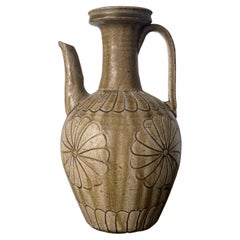Items Similar to Qingbai ewer with slip decoration of two phoenix and lotus leaves, Yuan Dynasty
Want more images or videos?
Request additional images or videos from the seller
1 of 7
Qingbai ewer with slip decoration of two phoenix and lotus leaves, Yuan Dynasty
$2,950
$5,90050% Off
£2,240
£4,480.0150% Off
€2,561.61
€5,123.2350% Off
CA$4,121.58
CA$8,243.1650% Off
A$4,584.09
A$9,168.1950% Off
CHF 2,393.67
CHF 4,787.3450% Off
MX$55,783.55
MX$111,567.1050% Off
NOK 30,570.84
NOK 61,141.6850% Off
SEK 28,670.05
SEK 57,340.1150% Off
DKK 19,118.30
DKK 38,236.6050% Off
Shipping
Retrieving quote...The 1stDibs Promise:
Authenticity Guarantee,
Money-Back Guarantee,
24-Hour Cancellation
About the Item
This small ewer is an exquisite example of Qingbai ware, known for its pale blue-tinged glaze. The vessel showcases the advanced ceramic techniques and artistic sophistication of the era. Its delicate form is enhanced by relief decorations depicting two phoenixes amidst lotus leaves, motifs rich in cultural and symbolic significance.
The body of the ewer tapers gently toward the base and is balanced by an elegantly curved spout and handle, the latter of which is finished with a slight twist typical of Yuan dynasty style. The relief decoration employs a technique that adds depth and texture to the surface, highlighting the craftsmanship of Yuan potters.
The phoenix, a mythical bird revered in Chinese tradition, symbolizes longevity and prosperity and is often associated with virtue and grace. The lotus leaves accompanying the phoenixes are emblematic of purity and enlightenment, echoing Buddhist teachings. The interplay of these symbols on the ewer suggests that it was more than a mere utilitarian object; it was imbued with cultural resonance and spiritual depth.
Period : Yuan Dynasty(1271-1368)
Type : Small Ewer
Medium : Qingbai Ware
Size : 9.0 cm(Height), 4cm(Diameter)
Provenance : Acquired in late 1990s, Hongkong
Reference : Art Gallery of NSW(Museum), Australia
Accession number 2311998
* Qingbai Ware
Qingbai ware, which translates to "blue-white ware," is a type of Chinese porcelain that was made at the Jingdezhen and other kilns in the porcelain-producing regions of China, primarily during the Song dynasty (960–1279) and continuing into the Yuan dynasty (1271–1368). It is known for its translucent quality and the pale blue-green glaze that characterizes most of its pieces.
The qingbai glaze was achieved using a small amount of iron in a reduction-fired atmosphere, which produced the subtle blue-green tint. The body of qingbai ware is typically made of a fine, white porcelain that is often referred to as 'artificial jade' due to its resemblance to the esteemed stone. The thinness of the body and the high firing temperatures used contributed to the translucent quality of the finished product.
Qingbai ware includes a range of items such as bowls, cups, vases, and ewers. The designs are usually simple and elegant, with an emphasis on the graceful lines and form of the objects. Decorative motifs, when present, are often incised, carved, or molded in relief and can include floral patterns, dragons, phoenixes, and other symbolic elements drawn from Chinese culture.
Over time, the technology and techniques used to produce qingbai ware evolved, leading to innovations in glaze and decoration that would influence later types of Chinese porcelain. Despite these changes, qingbai ware remains a distinguished example of the potters' art in Song and Yuan China, reflecting the refined aesthetic and cultural values of the period.
- Dimensions:Height: 3.55 in (9 cm)Diameter: 1.58 in (4 cm)
- Style:Ming (Of the Period)
- Materials and Techniques:
- Place of Origin:
- Period:
- Date of Manufacture:14th century
- Condition:Minor fading.
- Seller Location:seoul, KR
- Reference Number:1stDibs: LU9577238090742
About the Seller
4.8
Gold Seller
Premium sellers maintaining a 4.3+ rating and 24-hour response times
Established in 1999
1stDibs seller since 2023
38 sales on 1stDibs
Typical response time: <1 hour
- ShippingRetrieving quote...Shipping from: seoul, Korea South
- Return Policy
Authenticity Guarantee
In the unlikely event there’s an issue with an item’s authenticity, contact us within 1 year for a full refund. DetailsMoney-Back Guarantee
If your item is not as described, is damaged in transit, or does not arrive, contact us within 7 days for a full refund. Details24-Hour Cancellation
You have a 24-hour grace period in which to reconsider your purchase, with no questions asked.Vetted Professional Sellers
Our world-class sellers must adhere to strict standards for service and quality, maintaining the integrity of our listings.Price-Match Guarantee
If you find that a seller listed the same item for a lower price elsewhere, we’ll match it.Trusted Global Delivery
Our best-in-class carrier network provides specialized shipping options worldwide, including custom delivery.More From This Seller
View AllRare Qingbai Carved Ewer, Song-Yuan Dynasty
Located in seoul, KR
This Qingbai ewer features a rounded body with smooth curves, a short spout, and a looped handle, presenting a harmonious and balanced form. The lid is adorned with a flower-shaped f...
Category
Antique 15th Century and Earlier Hong Kong Antiquities
Materials
Ceramic
$4,470 Sale Price
70% Off
Yue Celadon Ewer, Late Tang-Northern Song Dynasty
Located in seoul, KR
This Yue ware celadon ewer features a gracefully rounded body that expands smoothly, complemented by a wide, flaring mouth. The translucent olive-green glaze envelops the surface, en...
Category
Antique 15th Century and Earlier Hong Kong Tang Antiquities
Materials
Celadon
$3,150 Sale Price
30% Off
Celadon Ewer with Straight Handle, Tang to Northern Song Dynasty
Located in seoul, KR
Celadon-glazed ewer characterized by its simple and functional design. The piece features a straight handle extending horizontally from the body and a short spout for pouring liquids...
Category
Antique 15th Century and Earlier Hong Kong Tang Antiquities
Materials
Celadon
$2,925 Sale Price
35% Off
A Molded Longquan Celadon 'Fu Shou' Ewer, Ming Dynasty
Located in seoul, KR
One side of the vase showcases a panel with the Shou character at its center, symbolizing longevity, while the opposite side displays the Fu character, signifying luck. The neck of the vase is adorned with leaves. There are similar types and decoration but varying in shape, resembling a pear, all from the same era and crafted in celadon, often referred to as 'fu shou' vases.
Period: Yuan-Ming Dynasty (1271-1644)
Region: Longquan, China
Medium: Celadon
Type: Ewer
Provenance : Acquired in late 1990s from Hongkong
Reference
1) British Museum - Museum number 1931,1118.5
(Type : Closely related)
2) Christies NEW YORK 24–25 MAR 2022 - Important Chinese Ceramics and Works of Art - Lot 1105
(Price realised : 9,450 USD / Type : Related)
3) Sotheby's New York 19 March 2024 - Chinese Art - Lot 172
(Price range : 15,000 USD - 20,000 USD / Type : Related)
* Ming Dynasty Longquan Celadon
Longquan celadon from the Ming Dynasty typically exhibits a more robust and heavier stoneware body compared to its Song Dynasty predecessors. The Ming era saw an evolution in celadon glaze, achieving a wider spectrum of green hues, from olive to bluish-greens. Ming celadons...
Category
Antique 15th Century and Earlier Hong Kong Ming Antiquities
Materials
Celadon
$1,995 Sale Price
50% Off
A Zhejiang Porcelain Ewer, Northern Song Dynasty
Located in seoul, KR
The oviform body is divided into few lobes. All covered in a finely crackled pale olive-green glaze. The surface and glaze characteristics are definitive, confirming the authenticity...
Category
Antique 15th Century and Earlier Hong Kong Antiquities
Materials
Porcelain
$2,925 Sale Price
35% Off
Qingbai Melon form water ewer, Five Dynasties-Northern song dynasty
Located in seoul, KR
The oviform body is divided into few lobes, and the shoulder is applied with a pair of small loops molded.
Period : Five Dynasties-Song Dynasty(907~1279)
Type : Ewer
Medium : Zheji...
Category
Antique 15th Century and Earlier Hong Kong Antiquities
Materials
Porcelain
$1,495 Sale Price
50% Off
You May Also Like
Antique Chongzhen Shunzhi Transitional Chinese Porcelain Ewer, 17th Century
Located in Amsterdam, Noord Holland
A very nicely decorated and Ewer in underglaze blue. The globular body rises to a flared neck decorated with tulips and supported by a high handle. The main decoration depicts a nice...
Category
Antique 17th Century Chinese Ming Vases
Materials
Porcelain
Antique Chinese Yue Chicken Head Spout Ewer
Located in Point Richmond, CA
A globular stoneware body that is well potted with a cup shaped mouth supported on a narrow tall neck. The characteristic chicken head form serves as the spout. The handle is pulled ...
Category
Antique 15th Century and Earlier Chinese Other Ceramics
Materials
Ceramic
Very Rare Ming Dynasty Porcelain Ewer with Ottoman Gem-Set Tombak Mounts
Located in London, GB
Very rare Ming dynasty porcelain ewer with ottoman gem-set tombak mounts
Chinese and Turkish, 16th/17th century
Measures: Tombak: height 20cm,...
Category
Antique 16th Century Chinese Ming Bottles
Materials
Multi-gemstone, Brass
Japanese Ko-Seto Stoneware Ewer with Carved Design
Located in Atlanta, GA
On offer is a rare Ko-seto (old seto) stoneware ewer from Kamakura period (12-14th century) Japan. The exceptionally heavily potted ewer is made of stoneware. The main body was likely hand-coiled with individually built handle, sprout and wheel-made neck and mouth assembled. It takes the basic form from the contemporary Chinese ewer...
Category
Antique 15th Century and Earlier Japanese Archaistic Ceramics
Materials
Stoneware
Provincial Chinese Glazed Water Jug, c. 1850
Located in Chicago, IL
This 19th-century kitchen vessel is coated inside and out with a dark brown glaze that clings to its ribbed sides with subtle color variation. Designed for serving water or tea, the squat jar features a narrow neck, small strap handles, and a short spout for pouring. The rounded shoulders are brushed with simple linework in a contrasting light brown glaze. Textured with pitted wear and other imperfections, the rustic vessel is wonderful as an unusual vase...
Category
Antique Mid-19th Century Chinese Qing Ceramics
Materials
Ceramic
Chinese Blue and White Porcelain Kendi, Transitional Period, 17th Century, China
Located in Austin, TX
A fine Chinese shipwreck blue and white decorated large porcelain kendi, or pouring vessel, Transitional Period, late Ming or early Qing Dynasty, mid...
Category
Antique 17th Century Chinese Qing Ceramics
Materials
Porcelain
More Ways To Browse
Antique Slip
Lotus Asian Art
Lotus Leaves
Lotus Porcelain
Ming Dynasty Blue
Stone Lotus
Porcelain Phoenix
Song Porcelain
Dragon And Phoenix
Styled By Phoenix
Blue Phoenix China
Ming Dynasty Blue And White Porcelain
Song Dynasty Vase
Thin Porcelain Chinese
Song Dynasty Porcelain
Ming Stone
Ming Dynasty Vases
14th Century China
